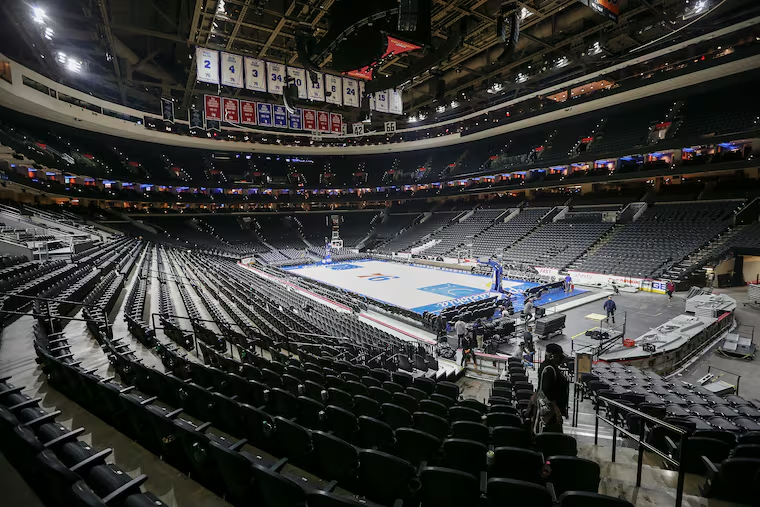There’s a noticeable COVID-19 effect on NBA season
The pandemic has taken away some of the normal excitement one feels heading into a season.

This NBA season already has a different feel.
It’s still early, of course. The 76ers won’t even have a full roster until their trade with the Oklahoma City Thunder for Danny Green and Terrance Ferguson becomes official on Tuesday.
Their season-opener against the Washington Wizards at the Wells Fargo Center on Dec. 23 could serve as a barometer for the new-look squad. We’ll definitely have a better grasp of what the Sixers’ talent level is after facing the Brooklyn Nets and Denver Nuggets in the ninth and 10th games of the 37-game first-half schedule.
» READ MORE: Sixers to open 2020-21 first-half schedule by hosting the Wizards on Dec. 23
Only 37 of the scheduled 72 games were announced on Friday to give the league maximum flexibility from March to the end of the season to reschedule games that might have been postponed due to COVID-19 conditions. The second-half schedule will be released near the 30-game mark, around mid-February, the league said.
But this past week, the Sixers participated in individual workouts at the practice facility. The players partook in Zoom media conferences, which took place instead of the usual Media Day availability.
As has always been the case in my previous seven seasons on the beat, the opening-media get-togethers were overloaded with optimism. Guys talked about being in great shape, how they improved their games in the offseason, and have new mindsets.
But there’s a different feel to this season.
Call it the COVID-19 effect.
» READ MORE: The Sixers’ Ben Simmons is healthy and ready to go after injury-plagued season
The Wells Fargo Center was rocking with excitement the last few seasons with 124 consecutive sellouts. It’s a place where the Sixers had a 29-2 record last season while feeding off the electricity of the crowd. But fans won’t be allowed in the arena at the start of the season due to the City of Philadelphia’s current COVID-19 restrictions.
Most of the league’s 30 NBA teams playing in their empty home buildings. But that’s nothing compared to what the Toronto Raptors will be going through. They won’t even be playing in their own country.
The Raptors are temporarily based Tampa, Fla. because the pandemic forced the closure of the United States-Canada border to non-essential travel. So they’re holding training camp at Saint Leo University and will play their home games at Amalie Arena.
All league-mandated media interviews will be via Zoom with no media access to practice. Team traveling parties will be limited to 45 people. According to the league’s health and safety protocols, travel parties “remain obligated to minimize risks to manage their health and enhance that of all individuals.”
The NBA is determined to take necessary precautions as the country could be headed for another shutdown. On Thursday, the CDC projected that coronavirus deaths could reach “close to 450,000″ by February.
But as careful as the league is, it’s hard to imagine conditions being as safe as they were during the NBA restart at Walt Disney World’s bubble. Sure, players will be tested every day, but they’ll be back on planes and staying in hotels on the road. They will also have the comfort of being in their own homes when not on the road. At home, players will have the luxury of being around family members and friends. They’ll also have the option to order food from restaurants that are open and taking orders.
So there are less restrictions than inside the bubble.
But one can argue it’s a matter of when – not if – before someone contracts the virus.
» READ MORE: NBA has 48 players test positive for COVID-19
There were 48 positive tests for COVID-19 out of the 546 NBA players tested from Nov. 24-Nov. 30 as part of the initial return-to-market testing phase.
The different feel to the season involves the unpredictability of the virus. The outcome of games could be less about talent and more about who’s available to play.
A player who tests positive and remains asymptomatic must refrain from workouts for 10 days. Afterward, he’ll have to work out individually for two days and must pass a cardiac screening before participating in full-team workouts.
As a result, a player will miss a minimum of 12 days if he tests positive.
“So, you know one of our guys or two of our key guys get the virus, and they miss 10 days or 14 days, that can be eight games in a 72-game season,” coach Doc Rivers said. “That could knock you out of the playoffs. So that’s a concern.”
That concern is warranted, and, for the moment, has taken away some of the normal excitement one feels heading into a season.